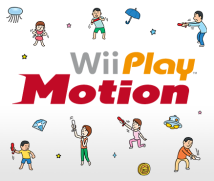2. Everyone Wants to Go Ghost-Huntin!
What kind of project did you have in mind as you made the prototypes? Let’s start with Ohshima-san from Arzest.
We put forth eight ideas. From among those, we made prototypes for three - Cone Zone , Spooky Search and Jump Park - and those made it into the final game. The prototypes were almost like the versions in the final product, but we did end up making a ton of adjustments, so it was a struggle right up until the end.
Especially when it came to Cone Zone.
Were you able to develop them so that you could tell all the minigames would be fun from their early development stages, or were you only able to feel that some of them were shaping up nicely partway through?
It went smoothly at the start, but we couldn’t seem to take the final step, and gradually everyone caught up to us.
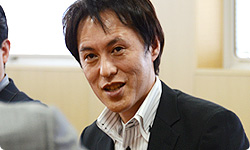
So, every company had to compete in terms of the completion level too. How about you, Naka-san?
When Nintendo announced the Wii MotionPlus accessory in the spring two years ago, I suggested to Nintendo a project called Haunted Tower. You defeated monsters outside the screen, so the living room was the scene of the action.
You pointed the controller in directions other than the television.
Right. But it got shelved. When this project came up, we worked on it some more and made a prototype, but it clashed with Ohshima-san’s project. They were both about ghosts. Ours was removed from competition, but in the two weeks left for prototypes, we made Trigger Twist .
It was a splendid comeback!
Yeah. Just before Nonaka-san and others came to talk to us, in about five days, we made a prototype for Trigger Twist, and they liked it. Nonaka-san said he wanted to ask us for a shooting game, so we were in perfect sync. I was as pleased as if I had hit a homerun with the bases loaded to take the lead!
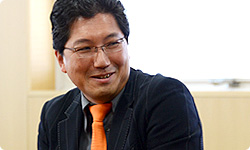
In the gaming world, things always greatly change when you make that one last try. Even in the special competitive environment we adopted this time, this was a classic example of something happening precisely because of such tenacity right up to the end, so it’s an interesting story. Taniguchi-san, how about your work at Vanpool?
We came up with all sorts of ideas before making a prototype, but as is all too common for us, we just came up with weird ones. One was using the Wii Remote Plus like a snake charmer’s flute, so when you played it, a cobra would rise up and move accordingly. Another was using the controller like a stick and trying to make sure ladybugs wouldn’t fly off... (laughs wryly)
I thought they were interesting when I heard them, but apparently Vanpool abandoned them before proposing them to Nintendo.
In the end, we made prototypes for four. One involved punching to break thousands of tiles. For another, you held the Wii Remote Plus sideways to mow the lawn. Another was a game in which you used a trampoline to save people jumping off a building. And the other involved catching the wind with an umbrella and racing along. Only the last one, Wind Runner , made it through. Of the four, it played the best, but was the least complete.
How did you feel when it was chosen?
I was glad, but I also thought, “Now what do we do?” It sounds fun to ride the wind with an umbrella, but it was hard turning that into a game. I even messed around with an umbrella at the office! (laughs)
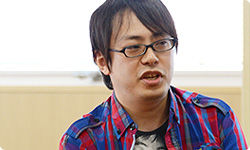
Nonaka-san, why did you choose Wind Runner?
It had a surreal atmosphere but controlling it felt great as you had that umbrella in hand and caught the wind.
When the wind hits your umbrella on the screen, you feel as if your hands are being pulled.
Along with those surreal images, I liked the way it’s a solid game and the way they stopped emphasising speed in favour of playing up the contrast between the wind tugging at the umbrella and a feeling of flying.
When you press the A Button, the umbrella opens, and when you let go, it closes. I also liked the way holding and releasing the buttons generated a sense of catching the wind.
Taniguchi-san, when did you begin to feel like it was really shaping up?
Like Takahashi-san just mentioned, we were emphasising speed at first. But then we adopted the element of riding the wind with the peculiar buoyancy of an umbrella. Soaring with the direction of the wind and gliding along added a vertical element of play that is unique to umbrellas. Then I knew it would work and development suddenly heated up.
Eto-san, how did you begin at Skip?
We came up with about 50 ideas at first, but we narrowed them down to five for prototypes, and it was Flutter Fly that actually came together. People wave fans in different ways, so it was difficult adjusting for that.
People wave fans in different ways, so the Wii Remote Plus would have to read data in many different patterns. Did you have lots of people wave fans to analyse how they did it?
Yes. We explained with a tutorial how to do it, added effects, and it turned into its current form.
At first, it was side-scrolling.
That’s right. At first you waved the fan sideways to keep balloons from falling. Then we changed it to a vertical-scrolling game in which you fanned balloons higher up in the air. As for Pose Mii Plus , at first we called it Topknot. You held the controller on top of your head and tilted it in order to pass through a tunnel with obstacles. But the controls weren’t great.
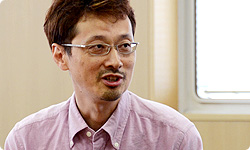
How did you fix the controller to your head?
You didn’t - you held it there with your hand. (laughs) I thought that in itself was fun, but...
How did Topknot become Pose Mii Plus?
While the very gesture of putting the controller on your head was fun, we concluded that most players were unlikely to do that. But I thought we should feature the element of passing through a hole and suggested using aeroplanes. Then Takahashi-san suggested combining Pose Mii25 with aeroplanes. 25. Pose Mii: A minigame included in Wii Play. Players pose their Mii characters in order to fit three types of silhouettes.
It was originally a game about avoiding obstacles, so the structure was the same.
And you had another prototype, right?
Yes. We also had a game about searching for ghosts. (laughs)
Huh? Do you all really want to go ghost-hunting so badly?
I guess so! (laughs) Skip came up with a game in which you rode in a cart and looked for ghosts. The ghosts would show up on camera, but you can’t actually see them, so you look at the screen as you shoot.
What Arzest really wanted to do was suikawari (watermelon splitting: a game similar to piñata, the players take turns trying to hit a watermelon while blindfolded). You know how someone blindfolded swings down according to the directions everyone else gives? But we realised that people all over the world would be playing it and thought ghosts would go over better. That’s how it turned out to be a game in which you listen to others and get rid of ghosts.
I can really identify with Eto-san and Ohshima-san’s ideas, because two years ago we had an idea about riding a cart and shooting ghosts. (laughs) Everyone would hold a Wii Remote controller, which would make sounds and vibrate, and everyone would say, “To the right! Right!” and “Over there, over there!” and have a raucous time playing. In that sense, suikawari and ghost-hunting are quite similar.
Uh-huh.
One key characteristic of the Wii Remote Plus is that it reacts outside the television screen. The concept of something you can’t see - not on the screen, but in your living room, led to the ghost idea. That’s why everyone was thinking along the same lines.
